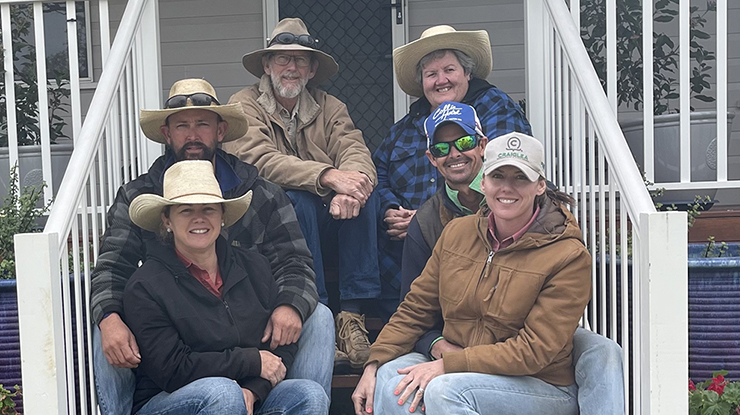 Leon and Ree Price with their daughters Jess Morton and her husband Matt and Ash Duncan and her husband Nick.
Leon and Ree Price with their daughters Jess Morton and her husband Matt and Ash Duncan and her husband Nick.
As the third-generation caretakers of their family’s Maranoa property, Queensland beef producers Ash Duncan and Jess Morton are driving productivity, from the ground up.
The sisters, along with their spouses and parents, are working on a succession plan to ensure the long-term sustainability of ‘Mount Hope’, Wallumbilla, and provide a sound home base for future endeavours.
Pasture improvement
The property’s soil types are variable, so Ash and Jess were looking for a program to help improve their pastures which, in addition to native grasses, are a mix of buffel, Rhodes grass, bluegrass, digitaria and black speargrass.
“Some of our pastures were getting a bit tired,” Ash said.
“It could have something to do with the season – we haven’t had as much rain as normal compared to this time of year – but we thought if they’re in need of fertilising, that’s something we can do.”
When Ash saw MLA’s PayDirt North – co-delivered by Peter Spies and Jill Alexander – advertised on Facebook, it was exactly what she had been looking for.
“It seemed to tick all the boxes,” she said. “I had met Jill before, on a Nutrition EDGE course, so I reached out to her and got our names on the list.”
They volunteered to host the first session at Mount Hope, where Peter spent half a day on the property, discussing their goals and priorities, and taking soil samples.
“The pastures are not getting the height that they used to, which could be due to some sort of limiting factor, such as nitrogen or phosphorus. That will come back in the soil test,” Ash said.
Strategic grazing
Once the pasture improvement program is underway, Jess and Ash want to split paddocks and start resting them. Previously, paddocks were continuously grazed and the bulk of the paddocks weren’t rested.
“We picked the areas that were most in need of improvement,” Ash said.
They targeted a paddock which was separated into two by a creek.
“The first part we sampled had been continuously grazed and was looking very tired.
The area on the other side of the creek had been cutter-barred and improved, but had bulk feed which cattle were not utilising,” Ash said.
Their plan is to split the paddock in two (either side of the creek) so cattle will utilise the area with a bulk of feed, while enabling the continuously-grazed side to be spelled.
“We are also looking to see what the improved pastures are lacking so we can give them a bit of ‘oomph’. In pastures which haven’t already been improved, Peter let us know what would grow best in those areas.”
Their goal is to improve the pastures one at a time, with a view to getting the most out of them.
“The PayDirt program is great because we didn’t know we needed fertilising or exactly what we needed for each pasture. We’re waiting for the soil tests to come back now, which will show us what’s limiting, and we’ll go from there.”








